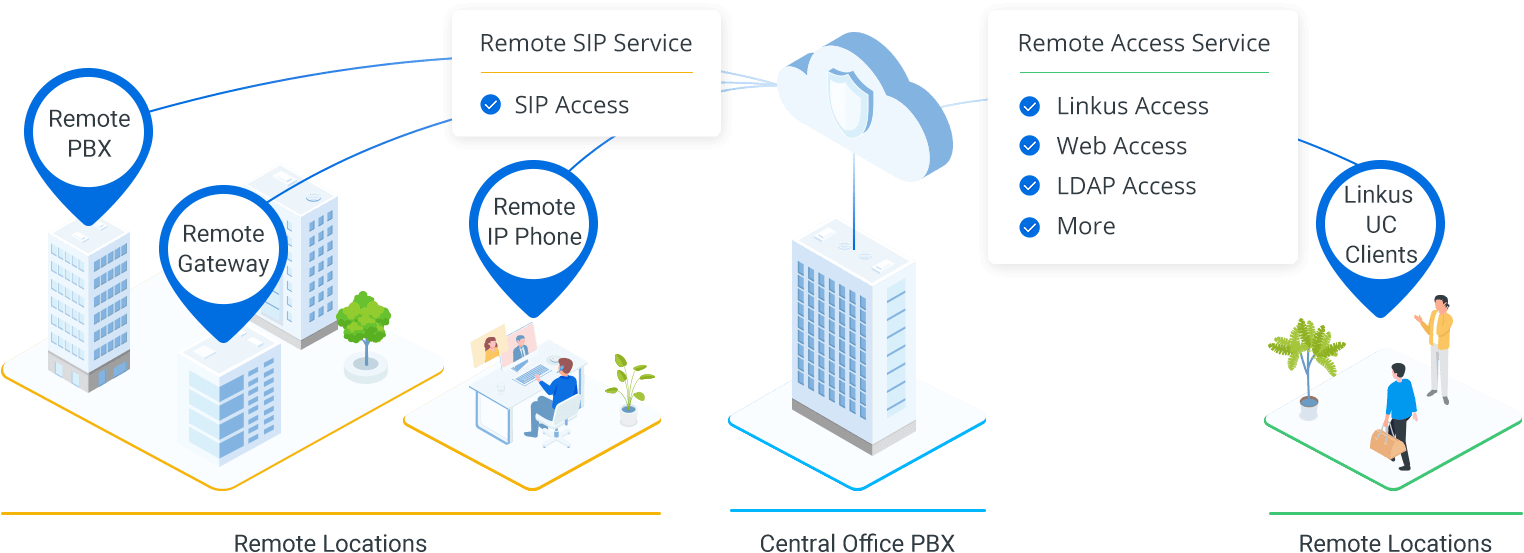
For multi-site businesses today, having a high-quality branch office VoIP network and choosing the services that come with it has never been more important. It’s imperative that all remote sites, branches, and mobile workers can effectively communicate, smoothly coordinate, and operate in tandem to achieve the highest efficiency.
The deployment of a multi-location VoIP system can be extremely beneficial to keep all dispersed aspects seamlessly connected and solve common branch office issues like spiraling inter-office call costs and remote workers’ disconnection. In this blog, we will dig into a couple of available options to extend VoIP to remote sites and discuss how to build a seamless multi-site telephony system.
How to Connect Your Remote Offices
There are several economical branch office solutions to link remote branches to corporate communications platforms based on the size and number of remote sites you are looking to connect. Beyond the size and number of branch offices, functionality, costs, ease of use, and reliability of an interconnection system should also be taken into consideration.

Secure Remote SIP Service feature on Yeastar On-premises PBX
1. Remote Extension Registration
For very small branch locations with only a few endpoints, one of the most cost-effective ways is to connect endpoints through a remote extension registration. A few phones/softphones can be located at any site without additional hardware investment on the branches. These phones can be registered to an on-premise telephony server (PBX system) in the main site via Yeastar PBX’s inbuilt remote access solution (FQDN feature), VPN, or DDNS (Dynamic Domain Name System) configuration. In this way, all voice calls are routed to the central IP PBX, which completes the call.
It’s worth noting that the remote connection via DDNS inevitably requires some firewall configurations like port forwarding on the router, which might pose potential security threats. If you are using Yeastar on-premises PBX, it’s recommended to use the PBX’s inbuilt remote SIP service, which eliminates the need for port forwarding and enables effortless remote extension registration as they were deployed in your PBX’s intranet.
- How to register remote extension on Yeastar P-Series PBX
- How to register remote extension on Yeastar S-Series PBX
2. Networking IP PBXs for Multi-Site & Branches
A premise-based, system-to-system multi-office VoIP network is ideal for larger separate offices, where branch office workers require the same level of communication and collaboration capabilities as those in large offices. In such kind of system-to-system multisite VoIP network, each location is equipped with its own PBX and is interconnected through the SIP trunk or the PBX’s exclusive built-in interconnection method.
The benefits of networking multiple PBX systems abound: you will be able to make free inter-office calls, share trunks among these offices to extend your available resources across your multiple locations and maintain control of employees and costs. Greater redundancy can also be achieved as each PBX can work as a stand-alone system even if your VoIP link goes down.
But there are still obstacles that lie ahead.

Figure 1: Traditional Way of SIP Trunking vs. Yeastar Multisite Interconnect
Networking multiple telephony systems can be complicated via the traditional way of SIP trunking. The necessity of port forwarding, static public IP address settings, and the number of SIP trunks to configure can be time-consuming and troublesome for the unprofessional. Thankfully, to remove these obstacles, some PBX providers offer easy solutions to intercommunicate multiple on-premises PBX. Yeastar S-Series VoIP PBX’s multisite interconnect feature allows you to connect your branches in minutes, and enjoy additional business-enhancing benefits like a single dial plan across all sites, centralized call processing, seamless inter-office call transfer, enhanced network security and more.
3. Utilizing VoIP Gateway to Connect Remote Sites
If you have more than a few endpoints in geographically distributed offices and do not want to deploy extra PBX systems on remote locations, you may need to deploy VoIP Gateways to connect your headquarters PBX system and your phones in the branches.
VoIP gateway solutions are perfect for small businesses and branch offices with analog voice infrastructures to capitalize on the power of VoIP technology. FXS gateway provides support for the integration of analog endpoints; FXO gateway can integrate local PSTN (Public Switch Telephone Network) and allow remote headquarter office to make local calls, which helps save long-distance charges; and GSM gateway could also offer local GSM trunk connectivity.
Typically, a VoIP gateway solution for branch offices can realize the following features: free inter-office calls, the use of corporate trunks for both inbound and outbound calls on branches, and vice versa.
4. Moving to the Cloud
When a business spans more than one location, the complexity of maintaining a multisite phone system can present major challenges. A cloud communications system or virtual phone system can free you from such trouble, as it serves all locations – large, small, global, and even at-home offices – via the Internet. By moving to the cloud, IT managers can reduce or eliminate the need for dedicated staff to support remote locations. All-inclusive communications services are delivered seamlessly anywhere: direct extension-dialing, call transfer, unified communication, and much more. As you can imagine, perfect for a company with a dispersed workforce.

Figure 2: Cloud Communications System for Remote Site and Mobile Workers
Dig Deeper on Efficient Branch Office Solution
Yeastar offers a complete range of cost-effective branch office solutions. Whether it’s hardware in a server room or a virtual system in the cloud, you can find the right solution that offers the best features that fit your company’s size and type of business. Take a look and find the best solution for you now!


good morning we want to set up your IPBX service for our office and branch
1-for matrix will have 47 ip phones.
2-branch “A” 2 ip phones (branch 15 km).
3-branch “B” 1 ip phone (30 km).
What hardware can you help us with in our project
Hi to all
I want know about the integration of Yeastar P560 or P570 with a Core solution of Cisco Call manager R11.5. To is posible make the integration or intercomunication
Any have information about this
To what extent it is possible to integrate P560 as a branch with the Cisco Call manager Core
In advance thanks for the atention and the comments
Hi Luis,
Our technical support personnel has received the ticket and will reply you as soon as possible.
Hello
is this possible with P-series.
I need to have a branch office solution regarding the following scenario:
1 main office
1 branch office
The branch should have its owns resources like local ISP Sip trunks or gateways using it on normal operation. The idea is to be registered to the main office on normal operation, but switch to the branch PBX in case off network or main office faillure.
or
More simply, just have a backup PBX in case off faillure
thanks
Hi Luis,
Our sales manager will reply asap. Have a nice day.
How do I connect Yeaster s330 – HQ and s50 at the branch to make calls?
Hi Moses, you can click here to creat a ticket and our technical expert will help you asap. Have a nice day.